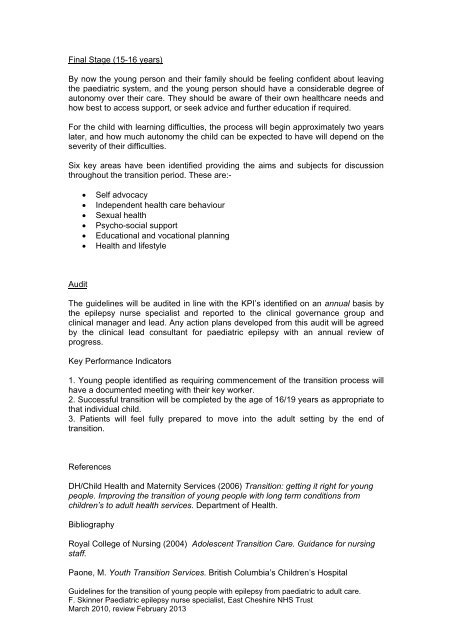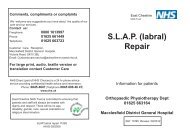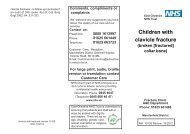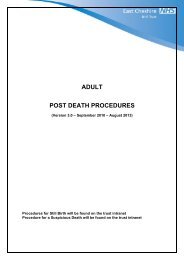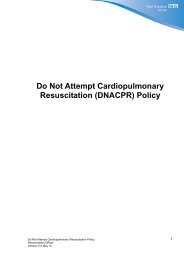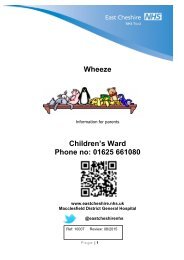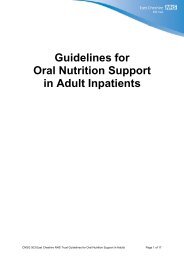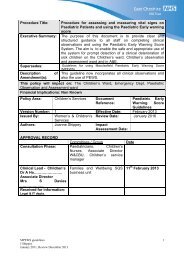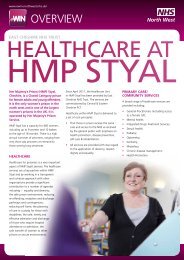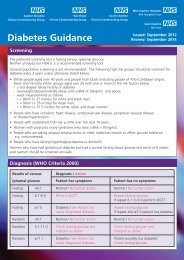The transition of young people with epilepsy from paediatric to adult ...
The transition of young people with epilepsy from paediatric to adult ...
The transition of young people with epilepsy from paediatric to adult ...
You also want an ePaper? Increase the reach of your titles
YUMPU automatically turns print PDFs into web optimized ePapers that Google loves.
Final Stage (15-16 years)By now the <strong>young</strong> person and their family should be feeling confident about leavingthe <strong>paediatric</strong> system, and the <strong>young</strong> person should have a considerable degree <strong>of</strong>au<strong>to</strong>nomy over their care. <strong>The</strong>y should be aware <strong>of</strong> their own healthcare needs andhow best <strong>to</strong> access support, or seek advice and further education if required.For the child <strong>with</strong> learning difficulties, the process will begin approximately two yearslater, and how much au<strong>to</strong>nomy the child can be expected <strong>to</strong> have will depend on theseverity <strong>of</strong> their difficulties.Six key areas have been identified providing the aims and subjects for discussionthroughout the <strong>transition</strong> period. <strong>The</strong>se are:-Self advocacyIndependent health care behaviourSexual healthPsycho-social supportEducational and vocational planningHealth and lifestyleAudit<strong>The</strong> guidelines will be audited in line <strong>with</strong> the KPI’s identified on an annual basis bythe <strong>epilepsy</strong> nurse specialist and reported <strong>to</strong> the clinical governance group andclinical manager and lead. Any action plans developed <strong>from</strong> this audit will be agreedby the clinical lead consultant for <strong>paediatric</strong> <strong>epilepsy</strong> <strong>with</strong> an annual review <strong>of</strong>progress.Key Performance Indica<strong>to</strong>rs1. Young <strong>people</strong> identified as requiring commencement <strong>of</strong> the <strong>transition</strong> process willhave a documented meeting <strong>with</strong> their key worker.2. Successful <strong>transition</strong> will be completed by the age <strong>of</strong> 16/19 years as appropriate <strong>to</strong>that individual child.3. Patients will feel fully prepared <strong>to</strong> move in<strong>to</strong> the <strong>adult</strong> setting by the end <strong>of</strong><strong>transition</strong>.ReferencesDH/Child Health and Maternity Services (2006) Transition: getting it right for <strong>young</strong><strong>people</strong>. Improving the <strong>transition</strong> <strong>of</strong> <strong>young</strong> <strong>people</strong> <strong>with</strong> long term conditions <strong>from</strong>children’s <strong>to</strong> <strong>adult</strong> health services. Department <strong>of</strong> Health.BibliographyRoyal College <strong>of</strong> Nursing (2004) Adolescent Transition Care. Guidance for nursingstaff.Paone, M. Youth Transition Services. British Columbia’s Children’s HospitalGuidelines for the <strong>transition</strong> <strong>of</strong> <strong>young</strong> <strong>people</strong> <strong>with</strong> <strong>epilepsy</strong> <strong>from</strong> <strong>paediatric</strong> <strong>to</strong> <strong>adult</strong> care.F. Skinner Paediatric <strong>epilepsy</strong> nurse specialist, East Cheshire NHS TrustMarch 2010, review February 2013


